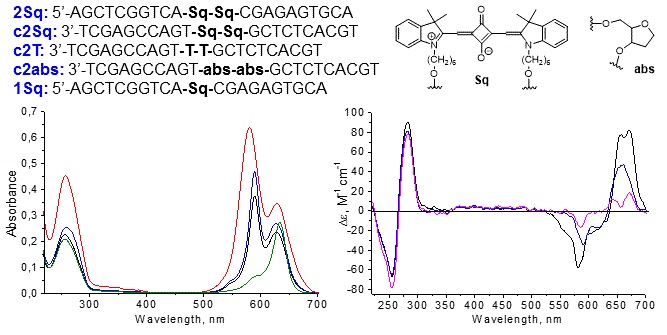DNA single strands and duplexes with two sequentially incorporated squaraine molecules
DNA´s remarkable self-recognition properties make it one of the most promising systems for studying interactions between synthetic molecules precisely incorporated into duplexes. Sequence-defined oligonucleotides modified with target molecules can be obtained by solid-phase synthesis using readily available reagents.
In this work, oligonucleotides 2Sq and c2Sq with two squaraine molecules sequentially incorporated in the backbone were synthesized by phosphoramidite approach and their absorption, fluorescence, circular dichroism (CD) spectra and quantum yields (Q.Y.) were studied before and after hybridization. The same spectral properties were investigated for duplexes 2Sq*c2T and 2Sq*c2abs where deoxythymidine (T) or abasic site (abs), correspondingly, were placed opposite squaraine (Sq) molecules. Melting temperatures (Tm) of the duplexes were also studied.

Left: absorption spectra of the squaraine-modified oligonucleotides 2Sq (black), c2Sq (blue) and 1Sq (green) and duplex 2Sq*c2Sq (red). Right: CD spectra of the duplexes 2Sq*c2Sq (black), 2Sq*c2T (magenta) and 2Sq*c2abs (blue). Conditions: 1 µM of each strand, phosphate buffer 10 mM, NaCl 100 mM.
The incorporation of two Sq units into single DNA chain results in the appearance of a new absorption band at shorter wavelength (588 nm vs. 633 nm for 1Sq). Additionally, the quenching of fluorescence is observed (3.1% vs. 29% for 1Sq). These effects are attributed to the dimerization of squaraines by H-type. The hybridization of 2Sq leads to more pronounced quenching of the fluorescence.
Oligonucleotides 2Sq and c2Sq do not show noticeable CD signals in the spectral range 500-700 nm. However, the CD spectra of the duplexes exhibits the signals with amplitude A = +141 (2Sq*c2Sq), +81 (2Sq*c2abs) and +36 (2Sq*c2T).